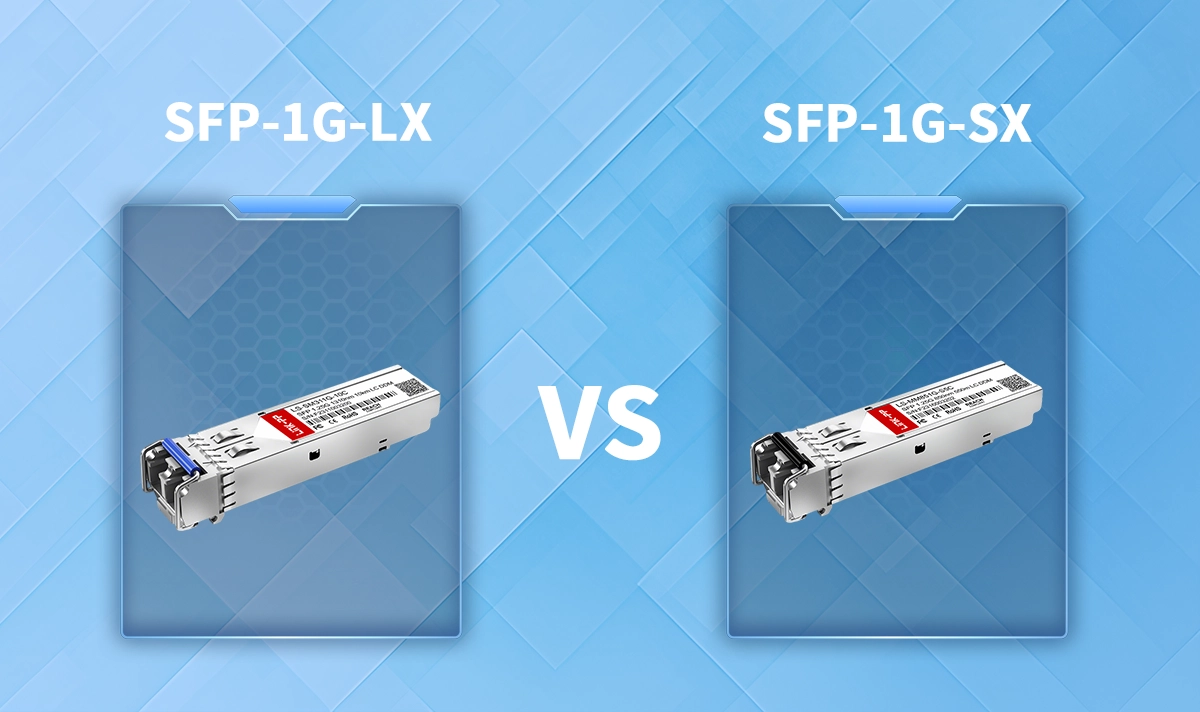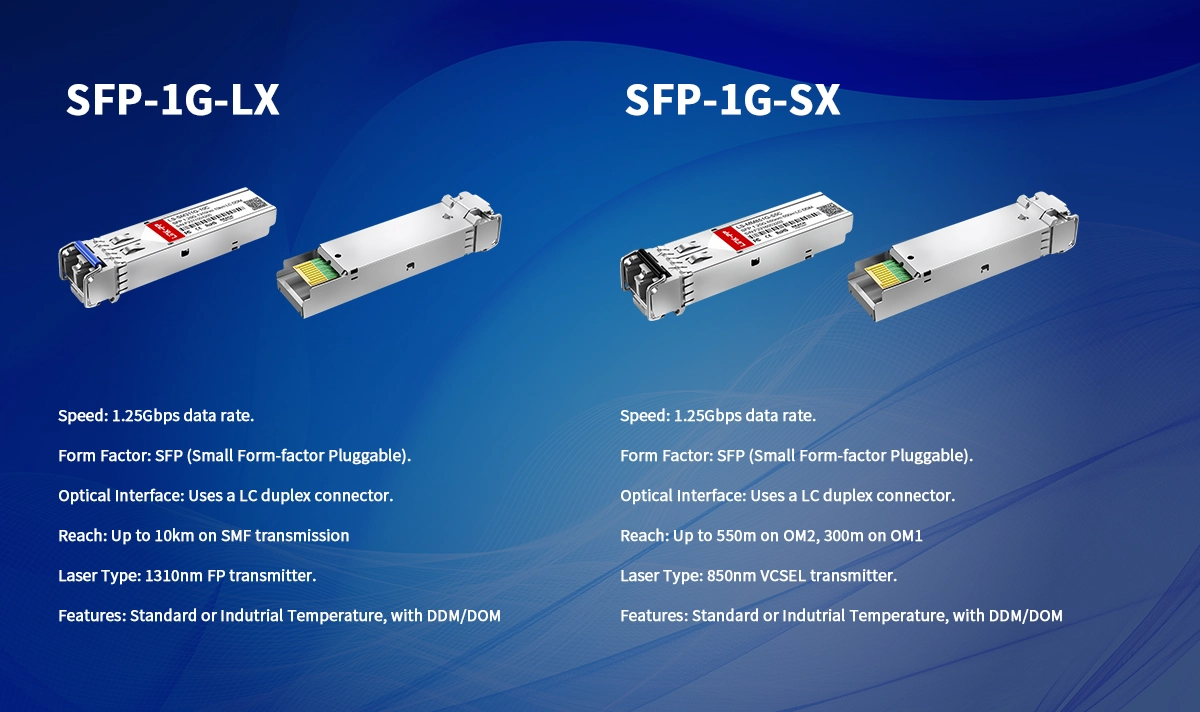
Confused between SFP-1G-SX and SFP-1G-LX? This guide demystifies the key differences between SFP-1G-SX (850nm, Multimode) and SFP-1G-LX (1310nm, Single-mode) transceivers. We compare technical specifications, transmission distance, compatible fiber types, typical use cases, cost considerations, and compatibility factors. Includes a detailed comparison table and guidance on selecting the right module for switches, routers, and media converters. Features compatible LINK-PP transceivers.
➤ SFP-1G-SX vs SFP-1G-LX: The Ultimate 1G Transceiver Comparison
Choosing the right Small Form-factor Pluggable (SFP) transceiver is critical for network performance, cost efficiency, and future scalability. Two of the most common 1 Gigabit Ethernet modules—the SFP-1G-SX and SFP-1G-LX—often cause confusion due to their similar naming but distinct applications. Understanding their technical differences, fiber compatibility, and ideal use cases ensures optimal network design and prevents costly mismatches.
1. Core Technical Specifications Compared
Feature | ||
|---|---|---|
Wavelength | 850nm (VCSEL Laser) | 1310nm (FP Laser) |
Fiber Type | Multimode Fiber (MMF - OM1/OM2/OM3) | Single-mode Fiber (SMF - OS1/OS2) |
Max Distance | 550m (OM3 MMF) / 300m (OM1 MMF) | 10km (Standard) / 20km (Extended LX) |
Cable Diameter | 50µm or 62.5µm | 9µm |
Key Standard | IEEE 802.3z 1000BASE-SX | IEEE 802.3z 1000BASE-LX |
Typical Cost | Lower | Higher |
2. Deep Dive: Wavelength & Fiber Compatibility
SFP-1G-SX (850nm): Designed for short-range transmission over multimode fiber (MMF). Uses lower-cost Vertical-Cavity Surface-Emitting Lasers (VCSELs). Performance heavily depends on fiber grade (OM1, OM2, OM3). Ideal for data center racks, intra-building links, or campus backbones under 550m.
SFP-1G-LX (1310nm): Engineered for longer distances using single-mode fiber (SMF). Employs Fabry-Perot (FP) lasers. Its key advantage is distance versatility – works on both MMF (using mode conditioning patch cables) and SMF. Essential for metro networks, ISP deployments, campus backbones exceeding 550m, or future-proofing for potential SMF upgrades.
🔍 Pro Tip: Attempting to use an SX module over single-mode fiber (or an LX module over very old OM1 MMF without mode conditioning) will cause link failure or excessive errors. Always verify fiber plant specs before selecting modules.
3. Distance Capabilities: Why It Matters
SFP-1G-SX Distance:
OM1 (62.5µm): Up to 300 meters
OM2 (50µm): Up to 500 meters
OM3 (50µm Laser Optimized): Up to 550 meters
SFP-1G-LX Distance:
Over SMF (9µm): 10km (Standard), 20km (Extended options like LINK-PP LS-SM311G-20C exist)
Over MMF (Requires Mode Conditioning Patch Cord): Up to 550m (Avoids Differential Mode Delay issues)
Distance is a critical factor in network topology planning. Overestimating SX capabilities or underestimating LX requirements leads to signal loss and downtime.
4. Application Scenarios: SX vs LX in the Real World
SFP-1G-SX is Best For:
Connecting switches within a single server rack or adjacent racks.
Inter-building links on a campus under 550m using existing MMF.
Cost-sensitive projects with confirmed short-distance MMF runs.
Legacy network upgrades where MMF infrastructure is fixed.
SFP-1G-LX is Best For:
Links between buildings exceeding 550m.
Deployments using existing or new single-mode fiber.
Environments demanding future scalability to 10G (using SMF).
Networks requiring longer reach flexibility on a mix of fiber types.
ISP access networks or WAN connections.
5. Compatibility & Interoperability
Both SX and LX modules adhere to the SFP MSA (Multi-Source Agreement), ensuring mechanical and electrical compatibility with major switch brands (Cisco, Juniper, HPE Aruba, Dell, Brocade, etc.). However, vendor coding remains a hurdle. LINK-PP transceivers, like the LINK-PP LS-MM851G-S5C and LINK-PP LS-SM311G-10C, offer guaranteed compatibility with major OEMs at a fraction of the cost, bypassing proprietary lock-ins. Always perform a compatibility check before deployment.
6. Cost Analysis: Initial Outlay vs TCO
While SFP-1G-SX modules typically have a lower upfront cost, the SFP-1G-LX offers greater long-term value and flexibility in many scenarios:
Infrastructure Cost: SMF cable costs more per meter than MMF, but its long-distance superiority often negates this for runs >300m.
Module Cost: LX modules are generally 20-40% more expensive than SX.
Future-Proofing: Investing in SMF infrastructure and LX modules simplifies future upgrades to 10G (SFP+), 25G, or even 100G. Migrating from MMF often requires complete re-cabling.
Operational Simplicity: LX's ability to work on both SMF and MMF (with a patch cord) simplifies spare stocking.
💡 Considering an upgrade? Factor in future bandwidth needs. Deploying SMF with LX modules today eases the transition to high-speed optics like SFP+ or QSFP28 later. LINK-PP offers compatible 1G/10G/25G/100G modules for seamless scaling.
➤ SFP-1G-SX vs SFP-1G-LX: How to Choose the Right Module?
Distance Required: Measure exact link distance. Add 10-20% margin.
Existing Fiber Type: Inspect cable jackets (OM1/OM2/OM3 for MMF; OS1/OS2 for SMF).
Future Plans: Will this link need >1G within 3-5 years?
Switch Compatibility: Verify vendor support/coding requirements.
Budget: Balance initial module cost vs long-term cabling/upgrade costs.
For Distances <550m with MMF: SFP-1G-SX (e.g., LINK-PP LS-MM851G-S5C) is the cost-effective choice.
For Distances >550m, SMF, or Future-Proofing: SFP-1G-LX (e.g., LINK-PP LS-SM311G-10C or LINK-PP LS-SM311G-20C for 20km) is the strategic choice.

Why Choose LINK-PP Optical Transceivers?
LINK-PP delivers high-performance, MSA-compliant SFP modules like the SFP 1G SX and SFP 1G LX, rigorously tested for interoperability with leading switches and routers. We offer:
Lifetime Warranty & 24/7 Support: Guaranteed reliability.
Deep Inventory: Fast shipping on SFP optics, SFP+ modules, and QSFP solutions.
Cost Savings: Up to 90% vs OEM pricing.
Free Firmware Updates: Ensure ongoing compatibility.
Ready to Optimize Your Network?
👉 Get a Free Compatibility Check: Send us your switch model & requirements.
👉 Shop Reliable 1G SFPs: Browse SFP-1G-SX & SFP-1G-LX stock.
👉 Consult an Expert: Need help designing your fiber infrastructure?
➤ Conclusion
The SFP-1G-SX vs SFP-1G-LX decision hinges on distance, fiber type, and future needs. SX excels in cost-sensitive, short-reach MMF environments. LX provides unmatched versatility for longer distances, SMF, and future upgrades. By understanding these differences and leveraging cost-effective, compatible solutions like LINK-PP optical transceivers, you can build a high-performance, scalable network without overspending. Always audit your fiber plant and switch compatibility before purchasing.
➤ FAQ
What is the main difference between SFP-1G-SX and SFP-1G-LX?
You use SFP-1G-SX for short distances with multimode fiber. You use SFP-1G-LX for long distances with single-mode fiber. The SX module works up to 550 meters. The LX module reaches up to 10 kilometers.
Can you use SFP-1G-SX and SFP-1G-LX in the same switch?
Yes, you can install both types in the same switch if the switch supports them. You cannot connect an SX module directly to an LX module. Each link must use the same type at both ends.
Which module costs less, SFP-1G-SX or SFP-1G-LX?
SFP-1G-SX usually costs less than SFP-1G-LX. The SX module uses simpler technology and supports shorter distances. The LX module supports longer distances and uses more advanced components.
How do you choose the right module for your network?
Check your fiber type and the distance you need. Use SFP-1G-SX for multimode fiber and short links. Use SFP-1G-LX for single-mode fiber and long links. Always match the module to your existing cables.
Can you mix multimode and single-mode fiber in one link?
No, you cannot mix multimode and single-mode fiber in one link. You must use the same fiber type and the same SFP module type at both ends for a reliable connection.
➤ See Also
What is a 1000BASE-SX SFP Optical Transceiver
Understanding 1000BASE-LX SFP for Modern Networks
What Is Single Mode Fiber (SMF)?
OM1 OM2 OM3 OM4 OM5 Multimode Fibers Explained
What is the differences between Single Mode and Multimode Fiber?




